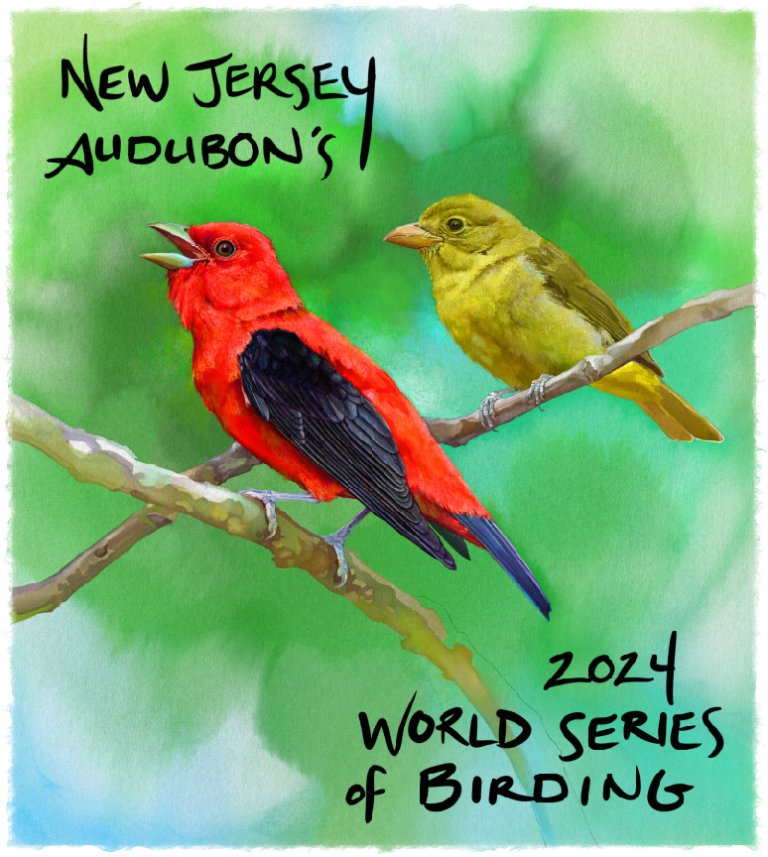Can you imagine seeing over 200 species of birds in one day? Sure, maybe in Colombia, the South American country that boasts the most species of birds in the world; 1878 species is the latest tally there. But how about in New Jersey, which boasts the highest density of species in North America?
It’s true! For a relatively small state, New Jersey is a place where you can see many different kinds of birds. According to eBird, which is the global bird database hosted by the Cornell Lab of Ornithology, 486 species have been found here in the past 20+ years. The highest diversity is during spring migration, which is happening now!
40 years ago, a group of experienced New Jersey birders were trying to figure out how anyone could break the elusive record of identifying 200 species of birds within 24 hours in the state of New Jersey. Huddled over their beers at the C-View Inn in Cape May, an idea was hatching. They had paper maps, paper checklists, and books like the Peterson Field Guide to Birds of North America. They could pinpoint locations for some of the rarer species with pencil on their maps, and could trace out different routes to try to “get” those species in addition to the more common ones.


They already knew the best approach would be starting in the north at midnight and working their way south to Cape May – for a full 24 hours of birding.
Then it hit them. What if we introduce the element of competition? There could be teams, and everyone goes out on the same day during peak migration, no matter the weather! That’s a level playing field; may the best team win!
What hatched was New Jersey Audubon’s World Series of Birding, which will take place for the 41st time on May 11, 2024. It began with 13 teams of seasoned and highly competitive birders all doing a full-state, 24-hour non-stop trip. Now it’s a beloved tradition open to birders of all ages and experience.
While over a dozen teams still embark on 24-hour odysseys, most participants join in other ways, whether birding in one spot, covering their home counties, or going carbon-free, mainly dawn to dusk or even a little less. There are Youth Birding teams, too. It’s New Jersey Audubon’s largest fundraiser of the year and a major fundraising platform for any wildlife conservation organization willing to pay a small entry fee and conduct a campaign of their own.
And what a way to spend a day. You and your teammates are in an all-out search for the next species. As on any bird outing, you listen first, then hone in on the sound to try to spot the bird your ears have found. Advanced birders can identify a species by sound alone!

For example, some WSB teams start their day in Belleplain State Forest just before dawn, due to its abundance of songbirds in spring. One by one, the birds begin to greet the day with their individual, distinct melodies. You might see a group of birders huddled together, hands cupped behind their ears, methodically listening and stating, “Eastern Wood Peewee. Yellow-throated Warbler. Chipping Sparrow. Eastern Phoebe. Acadian Flycatcher. Brown Thrasher. Eastern Kingbird. Bluebird. Blue-grey Gnatcatcher. Scarlet Tanager! Look up! There’s a Broad-winged Hawk!” With fingers pointing in various directions and members of the group responding, “Got it! Got it! Got it! Got it!”
Inevitably, the end of the day comes too fast and as teams tally up their count, someone might exclaim, “Wait a minute. We didn’t get a House Wren?! How is that possible?”
Oh, it’s possible. Because no team gets ALL the birds.

You can join the fun by either starting a team or donating to a team or participant. You can support the Cape May Bird Observatory’s Century Run or its Springwatch Swifts or Rambling Redstarts. Or, support the Wetland Institute’s Marshketeers! Philadelphia-based readers may want to support the Raven LunaChicks of the Delaware Valley Ornithological Society. Check out all the teams at www.worldseriesofbirding.org.
Nowadays, when teams leave home to start their World Series of Birding adventures, all they need is a smartphone. Armed with apps for navigation, group chats for sharing sightings, online bird identification aids, and an official WSB checklist system housed on the eBird platform, there’s no need for pen and paper, much less paper maps. And yes, teams do achieve totals of over 200 species!
They also need snacks. Lots and lots of snacks. And coffee. And birds, of course.
Lillian Armstrong is Special Events Director at New Jersey Audubon/Cape May Bird Observatory. A World Series of Birding veteran herself, she’ll be the first to tell you the World Series of Birding is the most special of all events! Learn more, participate and/or donate to your favorite team at www.njaudubon.org and www.worldseriesofbirding.org.








